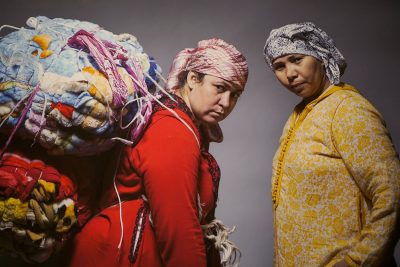
Colorful images and videos of Morocco’s history, culture and people were brought together in the exhibit “Looking Out, Looking In: Contemporary Artists from Morocco” for the first time on Feb. 7.
The exhibit, which portrays the culturally rich lives of Moroccans, is a collection by seven diverse Moroccan artists at Boston University’s Faye G., Jo, and James Stone Gallery at the College of Fine Arts.
The exhibit features the work of photographers and videographers Hassan Darsi, Wiame Haddad, Hassan Hajjaj, Randa Maroufi, Safaa Mazirh, Lamia Naji and Nour Eddine Tilsaghani and debuted with a panel discussion Thursday night. It will be on display until March 31.
According to the exhibit’s website, the artists are connected through their exploration of Moroccan identities, yet each brings a unique perspective through their different styles and backgrounds. At the opening event of the exhibit, guests were invited into a gallery that was split into two sides.
On the right side was “Looking In,” displaying art that represented the political and social spheres and challenges within Morocco. On the left was “Looking Out,” displaying the country’s colonial archives and art that explored the projection of Morocco into the outside world and how its struggles are tied to other countries.
The website detailed that the “Looking Out” section of the exhibition is made up of artists’ renditions of how outsiders view Morocco and “confront the historical biases inherent in the colonial gaze.” Artists in the “Looking In” section depict “moral and emotional experiences” and “complex social issues” of Moroccan culture.
Hajjaj’s “Zezo Tamsamani” is located in the middle of the exhibition. Moroccan Coca-Cola cans frame a glossy photograph of a professional Moroccan boxer, Zezo Tamsamani.
The Coca-Cola cans are used to evoke a sense of familiarity when one steps into the exhibit, in case they are unfamiliar with Morrocan culture, according to Cynthia Becker, a BU associate professor of African art and one of the curators for “Looking Out, Looking In.”
Tamsamani is pictured wearing a traditional blue Moroccan printed towel as a cape and his red boxing briefs and punching gloves. On his feet are traditional Moroccan shoes with Nike swooshes on both of them, symbolizing commercialism bleeding into the country, according Becker.
Haddad’s series “Ceux qui Restent” included photographs of letters written by Moroccan political prisoners, including some from the secret prison Tazmamart of former King Hassan II.
The series included photographs of other scenes from this time in history, such as prayer beads a prisoner made from secretly collected dates and olive pits, according to Haddad’s artistic statement.
“A lot of the [art] deals specifically with Morocco, but I think many of the themes have relevance here in the United States today,” Becker said.
She said people from cultures around the world can relate to oppressive histories, and many save and interpret objects to remember trauma.
In Mazirh’s series “AMAZIGH,” the artist takes photographs of herself partially undressed and creates a double exposure of her artwork by drawing the tattoos of indigenous people on a wall.
The gallery’s left side, “Looking Out,” features a wall with text that says, “these artists confront the paradoxes and traumas in contemporary Morocco and seek to bring attention to the memory of inequality, to release its creative energy, and to escape the trappings of colonial and postcolonial history.”
In an annex in the gallery, a video plays that documents Moroccan women making a traditional rug in a dark room, with the same piece of rug that they created to display on the front side of the room.
Hannah Palacios, a sophomore in the College of Arts and Sciences and the College of Communication, said she thought the gallery space was thoughtfully constructed.
“I like that you can take your time for each piece,” she said, “and you have enough wall space to look at it itself, but you can also step back and kind of look at everything as a whole.”
Michael Kiefer, 65, of Medford, said that the contemporary art in Morocco is very rich and filled with political observations and meaning.
“[The artwork] suggests that Morocco is a vibrant society right now with a lot of challenges, but a lot of wonderful opportunity,” Kiefer said. “I think that’s especially important because there’s so much turbulence everywhere in the world, but especially in the Arab world — and it’s great to see artists expressing themselves so freely and thoughtfully.”























































































































